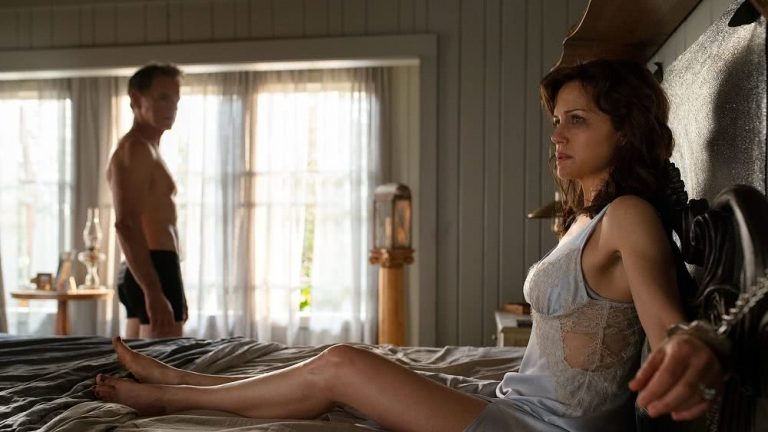The most shocking moment of Gerald’s Game – the 2017 Stephen King horror adaptation that isn’t about a scary clown – wasn’t when heroine Jessie (Carla Gugino) realised her husband’s (Bruce Greenwood’s) heart attack had left her handcuffed to a bed in the middle of nowhere. Nor was it the vivid flashback to Jessie’s childhood trauma. Even the film’s gory, stomach-turning ‘degloving’ scene – which, for the record, I had to watch through my fingers – wasn’t what shocked me the most.
It was a small detail that had me reeling. You see, given that Gerald’s Game is a “Netflix Original”, I saw it at home. And since I was watching at home, I was distracted. Glancing at my phone, fiddling with some paperwork – you know the drill. So, when a fly buzzed across the screen and landed upon the haunting face of Greenwood (a posthumous apparition of the man, produced by Jessie’s delirium), I thought nothing of it. Our house was open, insects are to be expected. But then Greenwood casually sucked the fly into his mouth and I had to stop and rewind the damn movie to figure out what was going on. I was genuinely disoriented by seeing something that seemed impossible.
A simple trick. Insert a computer-generated fly into the foreground and inattentive audiences will be fooled into thinking its on their screen rather than in the image. But anyone halfway familiar with the work of Gerald’s Game director Mike Flanagan would recognise that this is more than just a cute trick. Flanagan’s filmography exploits the fallibility of human perception to create legitimately unnerving horror, and it’s this approach that makes him this decade’s most exciting up-and-coming genre filmmaker (give or take a Jaume Collet-Serra).
Take Hush, Flanagan’s previous collaboration with Netflix. It’s a home invasion story with a simple twist: its protagonist, Maddie (Kate Siegel) is a deaf-mute. Flanagan delicately leverages Maddie’s vulnerability to add an additional layer to another otherwise conventional thriller; whereas most horror films set in houses find terror in bumps in the night, it’s their absence that’s terrifying here.
Ouija: Origin of Evil – the rare prequel to improve upon the original – plays a different trick altogether, opening on a supernatural séance that turns out to be a scam enacted by Alice (Elizabeth Reaser) and her daughters. By subverting his own scare by retroactively revealing it as a ruse – before, naturally, following it up with actual supernatural scares, Flanagan complicates the ‘it’s only a movie, it’s only a movie’ denial we rely upon when a horror movie cuts a little too close to the bone.
Whereas most horror films set in houses find terror in bumps in the night, it’s their absence that’s terrifying here.
Such manipulation of audience perception is very much in the tradition of classic horror. German horror touchstone The Cabinet Of Dr Caligari exploits audience identification through the then-innovative use of an unreliable narrator. Luis Buñuel and Salvador Dali’s surrealistic masterpiece Un Chien Andalou’s place in the horror canon might be debatable, but its transgressive, iconic shot of a razor slicing open an eyeball resonates for a reason beyond gore. In cinema, there’s nothing more unsettling than the violation of vision.
Classic gialli, like Dario Argento’s The Bird With The Crystal Plumage and Deep Red require their heroes to replay their memories in an attempt to understand the truth of the murder they’ve each witnessed. Slashers use subjective camerawork to align their audience with the perspective of the killer, forcing us to question our loyalties: are we sympathising with the helpless victims, or their omnipotent murderer?
Flanagan recognises that it’s not just what we see but how we see it that makes horror really get under our skin. Where many of his contemporaries exaggerate their scares with abrupt edits and loud sound effects, Flanagan – who edits all his own films – often overtly obscures his scares. Rather than jolting back in our seat at the sudden appearance of an unexpected antagonist, we’re left to stew in uneasy, uncertain anxiety. Less ‘it’s only a movie’, more ‘did … did I really just see that?’
Flanagan – who edits all his own films – often overtly obscures his scares.
What makes the fly moment especially clever is how it’s designed for television. Specifically, it’s designed for the way we watch television in the 21st century, with the omnipresent distraction of a second screen. Indeed, the absence of such distractions is why most horror films work best in a cinema – it’s a lot easier for a director to build suspense when they don’t have to worry about their audience glancing at their phone the second the pace slackens.
The director’s most sophisticated feature to date, Oculus, exploits that kind of inattention. Framed around an evil mirror able to mess with its owners’ heads – the tagline reads “You see what it wants you to see” – the film explores how our imperfect perception is entangled with modern technology. Flanagan’s characters find themselves tearing off fingernails instead of band-aids, or taking a bite from lightbulbs instead of apples – invariably while distracted by a computer or smartphone screen.
Who hasn’t stumbled into an obstacle while paying more attention to their phone than the footpath? Flanagan takes such small moments – something as simple a fly skittering across your television screen – and extrapolates them into existential terror. Maybe these scares aren’t flashy, or overtly in-yer-face. But Flanagan’s after something more insidious than the reptilian-brain jolts favoured by mainstream horror – something truly horrific; something that has you questioning your very own eyes.
Gerald’s Game is streaming on Netflix now.

































